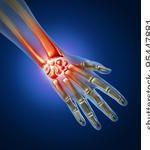 What is CTS? CTS is a repetitive strain disorder caused by compression of the median nerve as it travels through the carpal tunnel. It is the most commonly compressed nerve in the upper limb. Office workers, manual works are predisposed to repetitive strain wrist injuries due to the nature of computer work and repetitive wrist movements. Symptoms of CTS are pain, paraesthesia, and numbness in the fingers and hand, specifically the palmar aspect of the thumb, index and middle fingers, and radial half of the ring finger (aka the part of the ring finger closest to the middle finger.) Often, symptoms of CTS worsen at night. People often hear about cortisone injections providing instant relief and don’t hear much about all the other treatment interventions available under the conservative treatment section. In a research review, there is strong and moderate evidence for the effectiveness of corticosteroids (oral and injected) providing the most benefit, however, it’s still unclear in research as to how, but there appears to be an anti-inflammatory/neovascular role at play.
What is CTS? CTS is a repetitive strain disorder caused by compression of the median nerve as it travels through the carpal tunnel. It is the most commonly compressed nerve in the upper limb. Office workers, manual works are predisposed to repetitive strain wrist injuries due to the nature of computer work and repetitive wrist movements. Symptoms of CTS are pain, paraesthesia, and numbness in the fingers and hand, specifically the palmar aspect of the thumb, index and middle fingers, and radial half of the ring finger (aka the part of the ring finger closest to the middle finger.) Often, symptoms of CTS worsen at night. People often hear about cortisone injections providing instant relief and don’t hear much about all the other treatment interventions available under the conservative treatment section. In a research review, there is strong and moderate evidence for the effectiveness of corticosteroids (oral and injected) providing the most benefit, however, it’s still unclear in research as to how, but there appears to be an anti-inflammatory/neovascular role at play.
There weren’t any positive long term results with steroid use, only short term. Some serious and common side effects for steroid injections are osteonecrosis (the spontaneous break down of bone) and tendon rupture! A safe and effective intervention found in the research review was splinting, particularly night time splinting was found to be more beneficial than wearing a splint on a continuous basis. There is supporting evidence that targeted massage therapy is more effective than general massage for CTS. There isn’t any conclusive long term evidence for any treatment approach so far. Ergonomic keyboards were found to be moderately beneficial in reducing pain and improving hand function (for short term results only) when compared to a standard keyboard.
Surgical intervention outcomes:
According to surgical intervention, patients with severe carpal tunnel syndrome or whose symptoms have not improved after four to six months of conservative treatment (like after seeing a chiropractor) should be offered surgical decompression. Endoscopic and open techniques are equally effective, but patients return to work an average of one week earlier with endoscopic repair (the less invasive surgery). Surgery may provide improvements in some but doesn’t guarantee full recovery and CTS may reoccur. A good diagnosis and ultrasound/nerve conduction tests to rule out anything else is important.
In my clinical practice, I’ve had positive long-term patient outcomes thus far with the following combined treatment interventions for the upper limb: targeted Graston technique®, targeted active and passive muscle release technique, not just for the wrist, but along the median nerve path in the upper limb and neck, electro-acupuncture, mobilizing/adjusting the cervicothoracic spine, kinesiotaping and nerve glides/specific stretches and active at home exercises. There may be neck or upper limb involvement like a “double-crush” of the median nerve so examining these areas are integral. I found the combination of treatment to be highly effective in my practice, granted as the research review states, it’s important to have a good diagnosis and if the pain persists, I always recommend patients to speak to their general practitioners about ordering blood work to rule out any diseases that may be causing inflammation; to request an ultrasound and to be referred to a neurologist for nerve conduction tests to rule out anything else that may be contributing to the condition. Wearing a wrist brace may keep CTS from worsening and help decrease symptoms by keeping your wrist in a neutral position, but it won’t help much to decrease tension and any restriction in the wrist and arm area. The tension and restriction in the wrist joints and other areas may be contributing to the pain, numbness and weakness. A course of treatment along with patient education would be my first recommendation.
If you’d like to arrange a chiropractic appointment, email dr.mdavidovic@gmail.com or call
416-906-0767
Reference: Huisstede BM et al. Carpal Tunnel Syndrome. Part I Effectiveness of Nonsurgical Treatments – A Systematic Review. Department of General Practice and Rehabilitation Medicine, Erasmus Medical Center, Rotterdam, The Netherlands. Archives of Physical Medicine & Rehabilitation 2010; 91: 981-1004.
